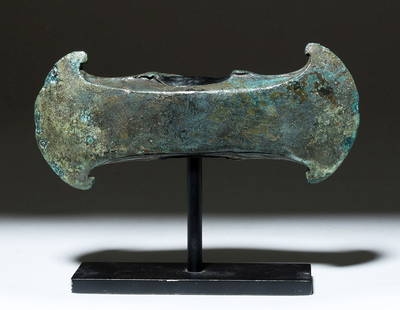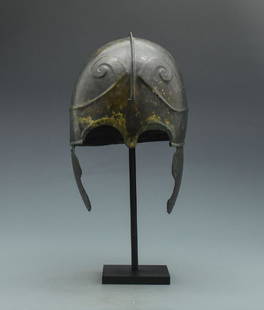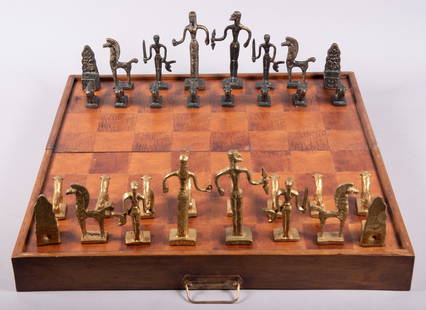
Rare / Published Greek Geometric Bronze Bull
Similar Sale History
View More Items in Collectibles
Related Collectibles
More Items in Collectibles
View More







Item Details
Description
Italic or Greek, Geometric period, ca. 8th to 7th century BCE. An incredibly rare, double-headed, leaded bronze bull, finely cast via the lost wax (cire perdue) process. Notice a suspension loop, now filled with deposits; this suggests that this piece may have been used as a weight as well as a votive. Animals were very popular motifs in the Geometric period, and small bronze figures were given as votive offerings at temples, and bull figures were oftentimes given as offerings at the Temple of Zeus of Olympia. Size: 3.25" W x 1.75" H (8.3 cm x 4.4 cm)
Interestingly, a few centuries after this piece was created, the Apadana palace in Persepolis (ca. 520 to 465 BCE) featured column capitals with animals in the form of twin-headed bulls as well as eagles and lions. All of these animals symbolized power, virility, and by extension royal authority.
We look to the Geometric period (ca. 900 to 700 BCE) for the roots of Classical Greek civilization as well as the mythos that much of Western culture is built upon. This was when Homer composed the Iliad and the Odyssey, and when graves full of rich and rare metal objects alongside the monumental kraters that served as grave markers told the story of warriors riding into battle in chariots for heroic (or sometimes villainous) rulers. Beyond the world of warfare and kings, the common people engaged in a difficult agricultural cycle whose vagaries led people to worship with cults dedicated to gods. Artistic figures like this one show a strong command of form and shape, and the ability of artists at this time to create instantly recognizable representations with relatively minimalist forms. The existence of votive figures demonstrates that farmers placed their trust in and prayed to the gods for help.
Published: J. Eisenberg, Art of the Ancient World, Vol. IV (1985), no. 175.
Exhibited: Ohio State University Art Museum 1987 to 1990, Picker Art Gallery, Colgate University 1990 to 2011, George Mason University, and Fitchburg Art Museum.
Provenance: T.F. collection, Shelby Township, Michigan, USA, acquired from Royal Athena in 1987; ex E. de Kolb collection, New York, US; Exhibited: Ohio State University Art Museum 1987 to 1990, Picker Art Gallery, Colgate University 1990 to 2011, George Mason University, and Fitchburg Art Museum. Published: J. Eisenberg, Art of the Ancient World, Vol. IV (1985), no. 175.
All items legal to buy/sell under U.S. Statute covering cultural patrimony Code 2600, CHAPTER 14, and are guaranteed to be as described or your money back.
A Certificate of Authenticity will accompany all winning bids.
We ship worldwide to most countries and handle all shipping in-house for your convenience.
#160825
Interestingly, a few centuries after this piece was created, the Apadana palace in Persepolis (ca. 520 to 465 BCE) featured column capitals with animals in the form of twin-headed bulls as well as eagles and lions. All of these animals symbolized power, virility, and by extension royal authority.
We look to the Geometric period (ca. 900 to 700 BCE) for the roots of Classical Greek civilization as well as the mythos that much of Western culture is built upon. This was when Homer composed the Iliad and the Odyssey, and when graves full of rich and rare metal objects alongside the monumental kraters that served as grave markers told the story of warriors riding into battle in chariots for heroic (or sometimes villainous) rulers. Beyond the world of warfare and kings, the common people engaged in a difficult agricultural cycle whose vagaries led people to worship with cults dedicated to gods. Artistic figures like this one show a strong command of form and shape, and the ability of artists at this time to create instantly recognizable representations with relatively minimalist forms. The existence of votive figures demonstrates that farmers placed their trust in and prayed to the gods for help.
Published: J. Eisenberg, Art of the Ancient World, Vol. IV (1985), no. 175.
Exhibited: Ohio State University Art Museum 1987 to 1990, Picker Art Gallery, Colgate University 1990 to 2011, George Mason University, and Fitchburg Art Museum.
Provenance: T.F. collection, Shelby Township, Michigan, USA, acquired from Royal Athena in 1987; ex E. de Kolb collection, New York, US; Exhibited: Ohio State University Art Museum 1987 to 1990, Picker Art Gallery, Colgate University 1990 to 2011, George Mason University, and Fitchburg Art Museum. Published: J. Eisenberg, Art of the Ancient World, Vol. IV (1985), no. 175.
All items legal to buy/sell under U.S. Statute covering cultural patrimony Code 2600, CHAPTER 14, and are guaranteed to be as described or your money back.
A Certificate of Authenticity will accompany all winning bids.
We ship worldwide to most countries and handle all shipping in-house for your convenience.
#160825
Condition
Losses to tops of heads of bulls, one larger than the other. Deposits in suspension loop as shown. Amazing green patina with brilliant almost emerald hues in areas as well as moments of russet red. Lucite stand in photos not included.
Buyer's Premium
- 24.5%
Rare / Published Greek Geometric Bronze Bull
Estimate $8,000 - $12,000
10 bidders are watching this item.
Get approved to bid.
Shipping & Pickup Options
Item located in Louisville, CO, usOffers In-House Shipping
Local Pickup Available
Payment

Related Searches
TOP




































































